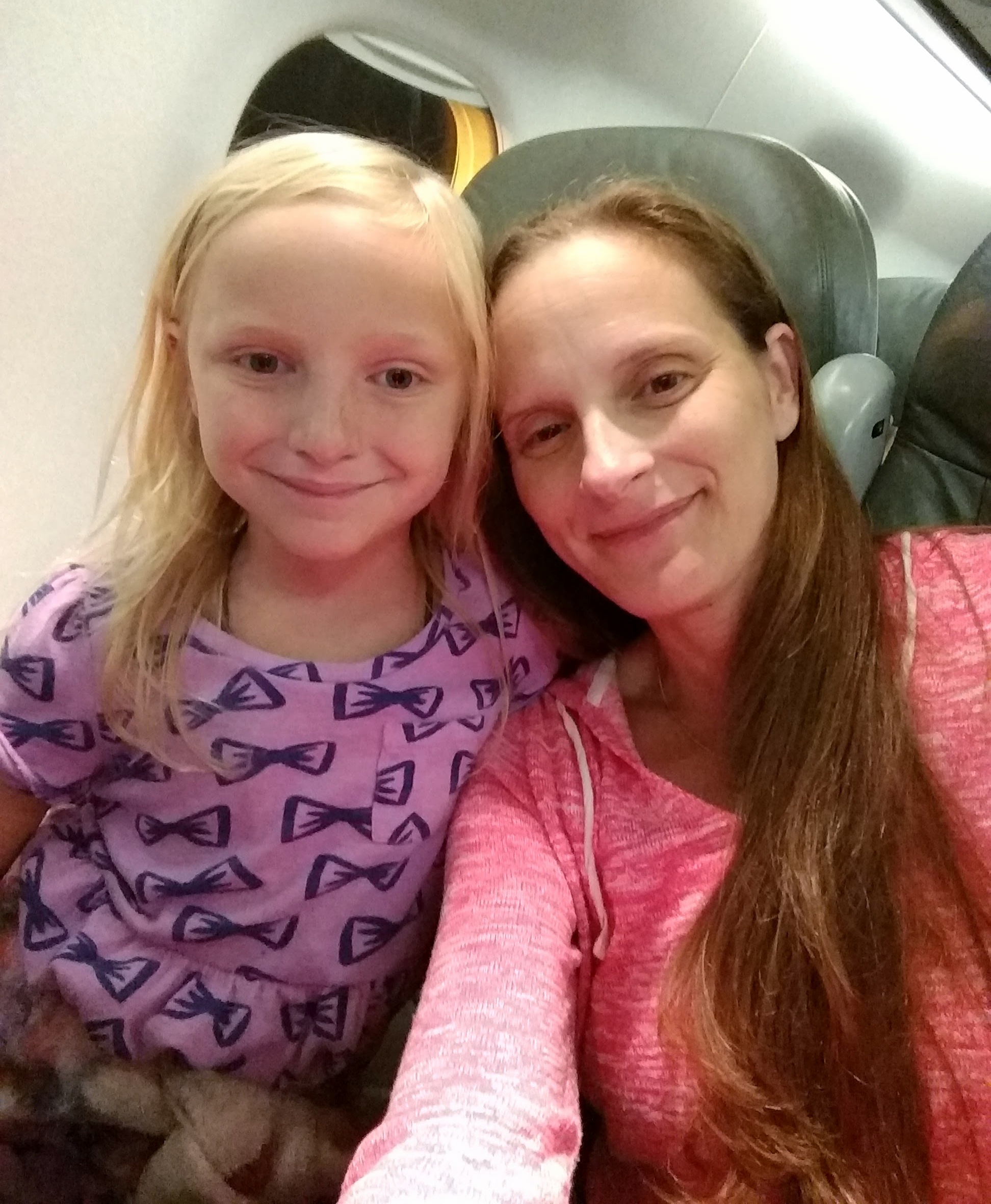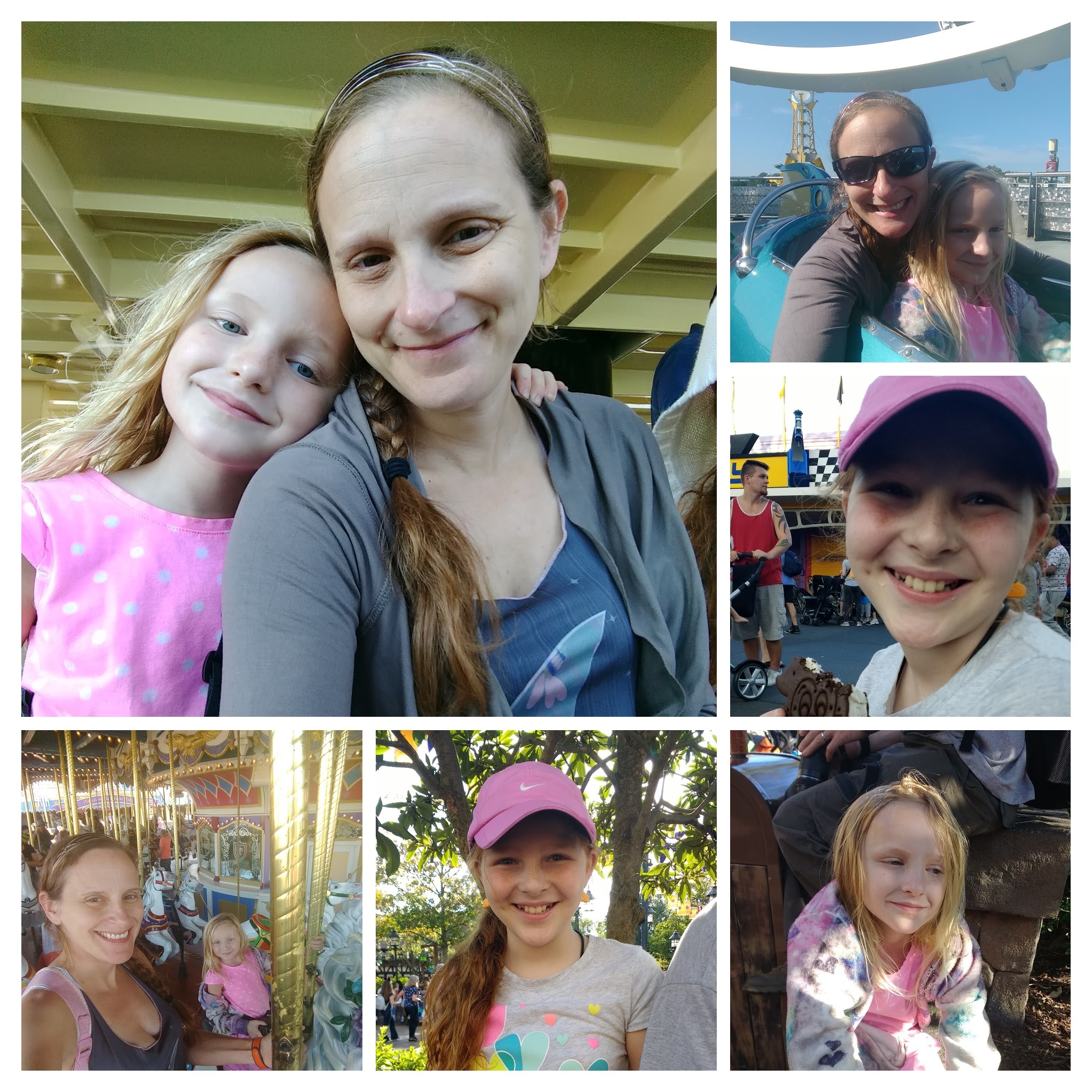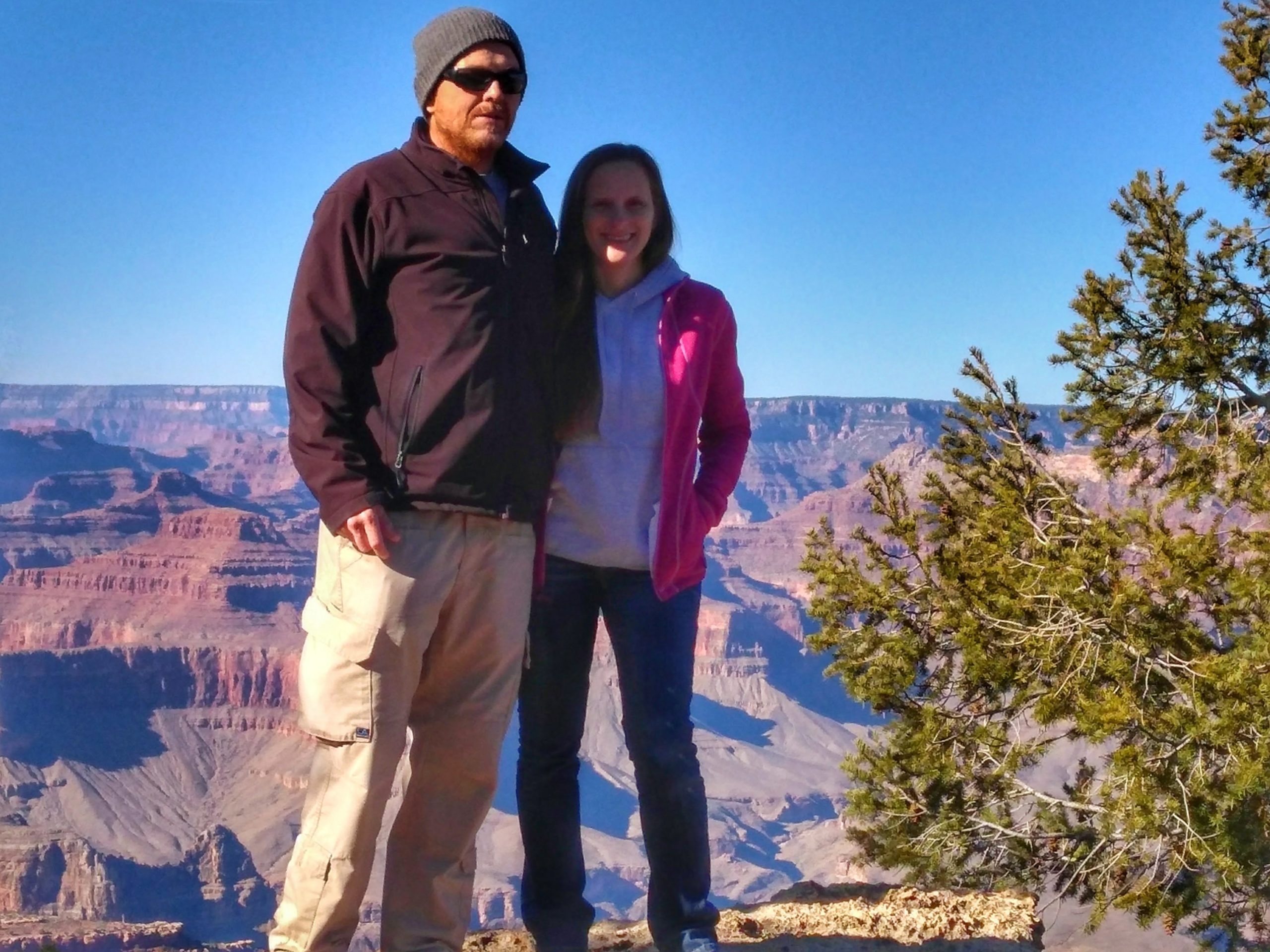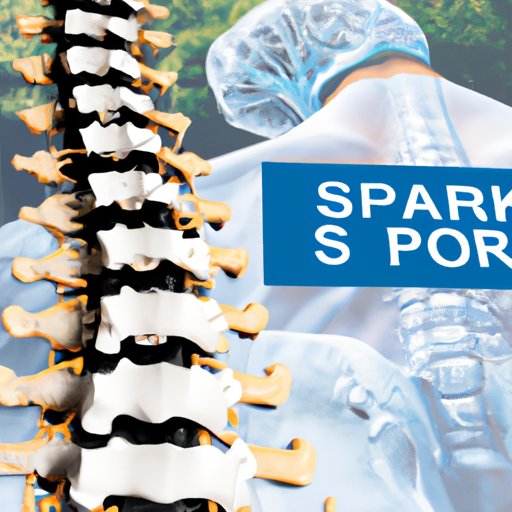- Skip to main content
- Skip to primary sidebar
- Skip to footer
Mommy Runs It
Life After Spinal Fusion Surgery [ Run | Travel | Joy ]

Spinal Fusion FAQ: How Soon After Surgery Can I Travel?
February 28, 2020 By Sharon Wilhelm 16 Comments
Question: How Soon After My Spinal Fusion Can I Travel?
Answer: It depends (obviously).
Everyone’s recovery timeline is different, and lots of factors need to be taken into consideration when making travel plans. I can’t tell you when YOU will be able to travel, but I can tell you when I did. For reference, I was fused from L4-S1 at age 42, and I did not experience complications during or after surgery. My BLT (bend, lift, twist) restrictions were lifted at 3 months post-op, and I was not given any specific restrictions regarding travel.

First Post-Op Road Trip
Road trips aren’t ideal at any point during your first year of recovery, but I’d especially avoid them (or any type of travel, really) for the first 6-8 weeks. You’ll probably be stiff and achy and unable to sit comfortably in one place for any length of time.
Of course some trips can’t be avoided. At around 7 weeks post-op, I was a passenger on a 4-hour road trip (8 hours total). The drive wasn’t fun, but it wasn’t terrible either. I was a little stiff, but I didn’t have any major issues, and I made it there and back without incident. We stopped periodically so I could get up and move around, which helped. You’ll definitely want to pack your pain meds for any type of travel stay during the early months.
(This was also my first post-op hotel bed. It wasn’t my best night sleep ever, but it wasn’t my worst night either.)
First Post-Op Plane Ride
Early in my 4th month of recovery, we took a family trip to Washington, DC . A flight from Florida to DC is about 2 hours. Much to my surprise, the flight was a piece of cake – I didn’t have any issues whatsoever.

I should also mention that our trip to DC involved a lot of walking, which also was easier than I anticipated. I did crash every day at 5:00 pm, but besides that, I felt sort of normal. This trip seems to mark a turning point in my recovery; it left me feeling hopeful and optimistic about living with a fused spine.
First Post-Op Theme Park
Six months after my fusion, we went to Disney World. This trip was a little bit tougher than my DC visit. I was actually at Disney World when I began to feel the first signs of an SI joint flare up. I was on my feet a lot, and I think our days were longer than they had been in DC. And like many people in this stage of recovery, my patience with my post-op body was running thin .

I don’t necessarily think that 6 months is too early for a theme park, but be mindful of your limits. Take breaks, try not to spend too much time on your feet, and definitely skip the roller coasters!
First Post-Op Cruise
At 18 months post-op, my family went on a 3 or 4 night Bahamas cruise. By then my energy level was more or less back to normal, and I was easily able to keep up with the rest of the family. The only challenge was the tiny, uncomfortable bed in our cabin, but it was relatively minor.

First Post-Op Cross Country Flight
A little less than two years after my spinal fusion, we flew from Florida to Nevada. The flight was about 4-5 hours, and it was uneventful. This was a big trip – we went to the Grand Canyon, the Hoover Dam, Valley of Fire State Park, and the Las Vegas strip. I was cautious during the hiking and climbing portions of our trip, but otherwise my back was a non-issue.

It Gets Easier
Are you sensing a pattern here? Traveling after a spinal fusion can be challenging, but it gets easier and easier over time. Since my surgery in May 2016, we’ve traveled to Puerto Rico , the USVI, Colorado , California, New York, and more (traveling is kind of our thing). We’ve been boating, skiing , hiking, kayaking, climbing – all things I thought I’d never be able to do with rods and screws in my back. Don’t give up hope. Your recovery may be slower than you hoped and/or expected, but give your body time, and hopefully travel will be in your future as well.
What is your experience with traveling after a spinal fusion? Please share your stories in the comments!
For more commonly asked questions, visit my spinal fusion faq page .

- Click to share on Facebook (Opens in new window)
- Click to share on Twitter (Opens in new window)
- Click to share on Pinterest (Opens in new window)
- Click to share on LinkedIn (Opens in new window)
- Click to print (Opens in new window)
- Click to email a link to a friend (Opens in new window)
- Click to share on Pocket (Opens in new window)
- Click to share on Reddit (Opens in new window)
- Click to share on Tumblr (Opens in new window)
You May Also Like:
About sharon wilhelm.
Sharon is a mom, a marathon runner, and a licensed therapist. She owns Mommy Runs It , a fitness & lifestyle blog. She is a passionate advocate of the Galloway training method and knows firsthand that everyday moms can run marathons. Connect with Sharon on Instagram .
Reader Interactions
Erica Boos says
December 10, 2023 at 6:32 pm
I’m both inspired and discouraged by your post and all the comments as well. I am 53 and fell from a horse shattering my L3 – emergency fusion of L3 and stabilization L1-L5. I am now on Week 7-8 post-op and hoping to return to teaching Yoga this January – from a chair until I am cleared for regular activity. Also, hopeful to roadtrip to Florida Panhandle to escape Wisconsin winter in February which would be 4 months post-op. I hear from my PT and surgeon, and now you as well, that more frequent stops to stretch will be needed. Anyway, really glad to have stumbled on this blog. Thank you – well wishes to you and everyone out there suffering (and surviving) back injury and surgery. It gets hard to stay positive and hopeful.
Christi says
October 10, 2023 at 9:44 am
^Shaughn…I’m 55 and just had fusion 2 weeks ago, been searching for a tennis player who has had fusion and returned to playing quickly. Would love to see your tips for a quick recovery. Christi
Kenneth A Farley says
September 26, 2023 at 4:21 pm
L5S1 decompression, laminectomy, and fusion. 2 mos in the hospital. pain is worse than before surgery. 13 months after the fusion during a routine 1hr long drive when I reached my destination out of the blue excruciating knee pain could not walk without a walker and then pain subsided somewhat but now encompasses hip, thigh, knee and down to ankle. Aching shooting constant pain. Cannot sit down very long at all. Limited sleep.
Amy Richlin says
January 7, 2023 at 12:14 am
Due to a long-standing commitment, I went on a month-long lecture trip 9 weeks after spinal fusion, involving both cross-country and international travel. It was pretty grueling but I got it done! Once I got off painkillers my energy and brain got back to normal (helped by adrenaline I’m sure). Disappointingly, when we got back I was still having a lot of pain when I tried to walk, and THEN they discovered that I also needed a hip replacement. I found out that’s not rare – the back pain can mask the hip pain. So my advice is, get a hip X-ray while you’re at it! I now have to wait another six months for surgery but am encouraged by all your comments to hope that someday I’ll be able to go for a walk again.
April 8, 2021 at 4:30 am
I had fusion 6weeks ago l5 s1 after first operation of discectomy was in lot of pain fkr 2years now after the fusion much better no more backpain so far little bit of legpain startting but i believed it will go away like i recover happen
Dena Wagel says
October 10, 2020 at 6:46 pm
You are such an inspiration! Gosh How I would love to be able to run…If I had someone i could start out with that also had spine issues like we do I think I would be more motivated..or Maybe Im just good at making excuses. I enjoy reading about your journey.
Priscilla says
February 2, 2022 at 3:47 pm
I had cervical spine surgery about 1 yr ago. I am trying to talk to someone who can relate to my condition. I can’t do any of the activities that was asked of me. I am still very fragile. I want to go on vacation but want to make sure I can travel by plane
August 31, 2020 at 7:56 am
Hi! I came across your blog after ploughing through a thousand internet articles hoping to find someone I could relate with. I too have spondy and a herniated disc at L5S1. I’m only 24 and the pain, numbness down my leg is excruciating on some days and still painfully annoying on others. I cannot walk for more than 30 minutes without needing to sit down. Currently, both my glutes have spasm-ed and I’m just lying in bed. I’m wondering if you had to have another fusion after your 1st round? I’m afraid I’ll have many in my lifetime once I get a fusion now 🙁 I’m really terrified and hoping to hear back from you
Shaughn Niland says
October 5, 2020 at 1:01 pm
Hi..i am an avid work out and tennis maniac. I had the same issue over Covid-19. I got the surgery and 6 screws and 90 days later I was back playing tennis and switched workouts to pilates. I am so happy as I couldn’t walk either. Up all night with pain and numbness. You got this girl! Get a good doctor, hospital and some PT. The strength you have being young will help your recovery. Im 56 BTW
February 2, 2022 at 3:54 pm
I enjoyed hearing your positive journey. I ad my second cervical spine surgery about 1 yr. Ago. I wish I can do some moral activity. I would like to travel by plane but I need to ask if it is ok. I just recently had a set back for pain and numbness over my whole body from just having my new office chair lowered. I feel like I am in critical condition instead of getting better. I believe I have the wrong expecting for the surgery recovery,
December 23, 2021 at 3:45 pm
I’ve had two fusion it’s painful and you think is this it. But get up go slow 50feet for a week 100ft next take pain meds and don’t give up good luck
May 14, 2020 at 11:05 pm
Thank you for this! It’s nice to see something long term, realistic, and positive.
Nura Muhammad says
January 31, 2022 at 12:14 pm
Hi guy, I had spine fusion surgery L5S1, now 7 days post op, there’s this radiating pain pain in my left leg, worsened by sitting and gets better as I walk around, Is it normal?
March 2, 2020 at 9:33 pm
Dear Sharon. Have been reading all of your comments hoping to find one comment with my symptoms. Had my 2nd fusion 4 months ago L2,3,4&5 1st was L4&5. No problem with 1st for 5 years. I have had very bad left hip/back pain since this last fusion. It feels like a knife is stabbing me when I walk or bend even little bit. Everyone says just give it time. Has anyone had any similar experience at all? Would so appreciate any response as I am very discouraged. Xrays at 3 month follow up show fusion fused successfully. Also had cyst removed during surgery. Thank you so much for this blog. I am 73 and trying everyday to remain upbeat and positive but this pain is really hampering my recovery Thank you in advance for any reply’s Pat
Sharon Wilhelm says
March 25, 2020 at 9:13 pm
Hi Pat. I’m sorry for my slow response – have things improved for you at all? I had pain in what sounds like the same area – it was related to my SI joint. Could that possibly be it? I really hope your pain has decreased. Stay well…
February 2, 2022 at 3:59 pm
You are not alone. I had cervical spine surgery and can’t do activities I live. I admire to you are older . I am only 57 years old and how to reach your age.
I'd love to hear your thoughts... Cancel reply
Have questions.
Check out my FAQ page or send me a message
Sharon Wilhelm, LCSW ran two marathons using Jeff Galloway's Run-Walk-Run training method. Despite a 2016 spinal fusion, she is an avid traveler and adventure seeker. She lives in Japan with her husband and two teenagers. Click here to learn more about Sharon's spinal fusion
- Rafath Baig, MD
- Addison Lofstedt, PA-C
- Justin Mauro, PA-C
- Spinal Stenosis
- Arm & Neck Pain
- Degenerative Disc Disease
- Spondylolisthesis
- Disc Herniation
- Spinal Arthritis
- Radiculopathy
- Spinal fractures
- Anterior Cervical Discectomy & Fusion
- Cervical Disc Replacement Surgery in Phoenix, Arizona
- Phoenix Spinal Fusion Surgery ALIF
- Lateral Lumbar Interbody Fusion
- Posterior Lumbar Interbody Fusion
- Transforaminal Lumbar Interbody Fusion
- Lumbar Disc Replacement Surgery in Arizona
- Laminectomy
- Endoscopic Spine Surgery
- Minimally Invasive Surgery
- Scoliosis Surgery
- Spinal Bracing
- Spinal Fusion Surgery
- Mesa Arizona
- West Valley Arizona
- Scottsdale Arizona
Traveling By Car After Back Surgery: How to Make It Happen
by Desert Spine & Scoliosis Center | Mar 15, 2023 | Surgery | 0 comments

If you are traveling after back surgery, by car, plane, or rail, you may have some understandable concerns. The good news is that the situation may be easier than you think! Let’s take a look at some of the most common questions that we get regarding travel after surgery.
How long after back surgery can I travel?
While the answer may vary depending on the specifics of your case and your overall health, you can often travel as soon after back surgery as your pain allows. Travel after a minimally invasive outpatient procedure may have different limitations than travel after a lumbar fusion , so it’s important to check with your doctor.
Remember that traveling after back surgery, by plane or car, in particular, may involve hours of sitting. While we recommend frequent breaks, as we will discuss below, If you are able to sit upright for a prolonged period of time after your surgery, you should have no problem with any type of travel.
How soon you can travel after back surgery will, and should, depend on your doctor’s recommendations, as they know your specific recovery progress best. for example, if your procedure required an inpatient hospital stay vs. a same-day, outpatient procedure, your travel plans may want to adjust.
But if things have gone to plan, and if you have followed your post-surgery instructions, then you may have few travel restrictions at all. Unless, of course, you plan to drive yourself.
After spine surgery, you may be prescribed pain medication. Don’t forget that driving under the influence of narcotics is illegal and unsafe. Johns Hopkins Medical Center says “You can drive when you feel up to driving and are not taking narcotic pain medications or after clearance by your surgeon.” the specific timing is dependent on your pain tolerance and how quickly you heal after surgery.
Do you have any tips for car travel after back surgery?
Car travel after back surgery can be a bit uncomfortable. Here are our recommendations for making it easier on yourself.
Take frequent breaks
Plan extra time into your journey that permits you to stop more frequently than you otherwise would. We recommend stopping at least every hour to permit you to move around. This will help you to avoid blood clots, and unnecessary stiffness.
Walk around
Driving or flying after surgery can be hard on your body, but it may also lead to blood clots of deep vein thrombosis (DVT). It’s important to get out of the car and walk short distances and stretch as recommended by your doctor. For air travel, getting out of your seat and walking between your seat and the galley may be plenty.
Adjust your Seat
Remember that car travel can be full of bumps and vibrations. So if you are traveling after back surgery by car, do what you can to make yourself comfortable. Many people find that reclining their seats helps distribute the weight and makes the bumps easier to handle.
Pillows and blankets
Speaking of relief, if you can, surround yourselves with pillows and blankets in the car. In fact, you may also want to consider other postoperative must-haves ( here’s a full list ), like ice, heat, and more.
Follow your doctor’s instructions
Probably the most important piece of equipment you can have on your road trip is your doctor’s instructions. Just because you are traveling, don’t neglect the guidance about when and how to move, stretch, twist, or bend. Traveling after back surgery, by car, or otherwise, is a perfectly fine thing to do unless it sets your recovery back.
We recommend discussing your plans with your provider before you go. And make a concrete plan based on their advice. As we’ve said before , “you should follow these specific instructions very carefully, and do not hesitate to ask for clarification if you need it. Failure to follow the directions carefully may result in permanent nerve damage after back surgery.”
If you follow these instructions, and those from your provider, you should be better situated to have a great trip!
For more information, or if you need a consultation, contact Desert Spine and Scoliosis Center today.
Submit a Comment Cancel reply
Your email address will not be published. Required fields are marked *
Save my name, email, and website in this browser for the next time I comment.
Recent Posts
- How to Know Spinal Disc Replacement Surgery is Right for You
- Spinal Fusion Recovery: What to Expect
- Is Minimally Invasive Spine Surgery Right for You?
- Why Does My Back Hurt?: Muscle Strain or Slipped Disc
- Considering Spinal Fusion? Have You Tried These 4 Things Yet?
Recent Comments
- February 2024
- January 2024
- November 2023
- February 2023
- January 2023
- October 2022
- September 2022
- August 2022
- February 2022
- January 2022
- December 2021
- October 2021
- September 2021
- August 2021
- January 2021
- December 2020
- Neck and Back Pain
- Uncategorized
- Entries feed
- Comments feed
- WordPress.org
When Is It Safe to Take a Flight after Back Surgery?
If you have recently had back surgery or have a surgery scheduled in the future, you may be wondering how it could affect travel plans. If you have air travel planned before or after surgery, it’s important to consult your doctor to talk about the associated risks, as flying after surgery can result in certain health complications. Here is some important information to know about flying after back surgery.
The Risks of Flying Post-Surgery
The risk of flying after surgery can vary depending on the type of surgery you’ve had, which is why it’s essential to talk to your doctor to figure out the risks associated with your specific situation. While the cardiac and vascular effects associated with anesthesia typically don’t last very long and don’t affect a person’s safety while flying, long-distance travel puts individuals who have just had surgery at high risk for developing blood clots. One of the most common risks of travel after surgery is a condition known as deep vein thrombosis (DVT), which involves blood clots forming in deep veins in the legs.
What to Know About Deep Vein Thrombosis and Air Travel
Deep vein thrombosis or DVT is one of the most common risks of flying post-surgery. Air travel places individuals at a higher risk for contracting DVT, as it involves sitting in the same position for a long time. When you’re seated on an airplane for an extended period, it can slow your circulation and cause blood to coagulate in the veins in your legs. While these clots can resolve on their own, they can break off, traveling to your longs and blocking blood flow. This can lead to a very dangerous and potentially fatal condition called pulmonary embolism.
While any person could develop a blood clot from staying sedentary for extended periods, the risk is higher for individuals who have recently had surgery. Some other factors that can elevate the risk for blood clots include:
- A recent hospital stay that involved significant periods of bed rest
- A family history of blood clots
- A recent cancer treatment
- Use of birth control or hormone replacement therapy
- A history of smoking
These are a couple of factors that can place individuals who have just had surgery at an elevated risk for contracting a blood clot while flying. It’s important to note that individual risk factors should be considered. Consulting with your doctor is the best way to determine your risks of flying post-surgery.
How to Lower Your Risk of Complications
Every person is unique, which is why it’s essential to talk to your doctor about determining whether it is safe to travel after your surgery. Your doctor can assess your personal medical history and make a suggestion specific to your situation.
If you choose to fly after your surgery, there are some ways to improve your circulation and lower your risks of developing blood clots. These strategies include:
- Extending your legs and flexing your ankles during your flight
- Walking around the plane for a few minutes every hour
- Avoid drinking any alcoholic beverages and drink lots of water
- Wearing compression tights to prevent blood from collecting in your legs.
These are a handful of strategies for mitigating the risks of flying post-surgery. Ultimately, the best way to determine when it is safe for you to fly after your back surgery is to talk to your doctor.
Consult the Trusted Spine Surgeons at OLSS
Are you suffering from back pain and don’t know what to do? Visit your local Orthopedic and Laser Spine Surgery to receive an expert medical diagnosis. At your local OLSS branch, you’ll find highly skilled board-certified surgeons who are trained in cutting-edge medical procedures for neck and back treatment. We pride ourselves on our ability to orchestrate personalized care plans that serve the unique needs of our patients in Florida.
To schedule an appointment with one of our skilled spine experts, call (855) 853-6542 or fill out our online contact form .
Related Blog Posts
How to know if hybrid lumbar spine surgery is right for you.
Hybrid lumbar spine surgery is an emerging surgical intervention used to treat patients with a combination of mechanical and inflammatory conditions in their lower back. It combines facets of different surgical procedures into one procedure…
Minimally Invasive Scoliosis Surgery For Children: What You Need to Know
If your child has scoliosis and requires treatment, you may feel confused and as if you’re heading into unfamiliar territory. Is it better to find a minimally invasive surgery for your child’s scoliosis? How should…
Lets get in contact
" * " indicates required fields

When Can I Travel After Spinal Fusion Surgery?
Still, you may be wondering how it could affect trip plans If you have lately had back surgery or have surgery listed in the future. However, it’s essential to consult your croaker about the associated pitfalls, as a trip after surgery can affect certain health complications If you have a trip planned before or after surgery.
When can I travel after spinal fusion surgery?
You may travel as soon as you feel comfortable, but avoid long-distance trips for four to six weeks or until after seeing your surgeon. In auto, the case should sit on a wholly reclined passenger seat next to the motorist or lie in the aft seat. We advise you to get up to stretch or walk for at least an hour when taking long passages.
Flashback that traveling after back surgery, by airplane or auto, in particular, may involve hours of sitting; if you’re suitable to sit upright for a prolonged period after your surgery, you should have no problem with any trip.

How to Lower Your Threat of Complications
Every person is unique, so it’s essential to talk to your croaker about whether it’s safe to travel after your surgery. Your croaker can assess your particular medical history and make a suggestion specific to your situation.
Still, there are some ways to lessen your rotation and lower your pitfalls of developing blood clots If you choose to travel after your surgery.
- Extending your legs and flexing your ankles during your trip.
- Avoid drinking any alcoholic potables and drink lots of water .
- Wearing contraction tights to help prevent blood from collecting in your legs.
Reduced Physical Activity During Spinal Fusion Recovery
You’ll see about two weeks after your lumbar spinal emulsion surgery to assess your recovery and, if the effects are going well, to clear you so you can begin further conditioning. In those first two weeks, you shouldn’t exercise or stretch while recovering at home. The effects you shouldn’t do while recovering from spinal emulsion surgery.
- Exercise( running, bike riding, weight lifting, etc.)
- Lifting heavy objects
- Carrying objects for long distances
- Running errands
Fundamental
Recovery advice.
Follow the advice of your croaker as you begin your recovery from back surgery, both in the sanitarium and at home. One of your croaker’s conventions will be a set of correct enhancement exercises to get you back to normal. Following those instructions can make all the difference in how snappily your recovery takes place.
Walking It Off
Your croaker and correct specialist will encourage you to begin a progressive walking program as soon as possible after your surgery. In addition to precluding muscle atrophy, walking helps you prevent blood clots from developing. Walking also helps get your intestine moving regularly again. While you’re still in the sanitarium after surgery, you may be encouraged to walk unless suitable.
Do one stage around your ward three to six times a day. It would help if you walked for five whole twinkles, up to six times per day, by day four, after you return home. By week two, up the number to 10 twinkles, three or four times daily, and by week three, to 15 twinkles.
By the sixth week following your surgery, you should walk for 30 twinkles twice daily. And that’s a good habit to continue when you’re completely recovered.
Benefits for Recovery from Back Surgery
You’ll notice the results snappily if you follow the instructions of your croaker and rehabilitative specialist. These benefits are
- Advanced muscle strength
- lower stress
- Regular bowel exertion
- Easier breathing
- Healthy weight loss( if demanded)
- Advanced posture
- More balance
Walking is the best low-impact exercise for most patients recovering from back surgery. Consider it to other types of exercise: it is the least harmful to your back, requires no special equipment, and offers the most significant advantages. Once that time comes, you could have grown to love walking so much that you include it in your healthy lifestyle.
Leave a Comment Cancel reply
Save my name, email, and website in this browser for the next time I comment.
Our Response to COVID-19 →
Technology & Innovation
Traveling for spinal fusion: just the facts.
Spinal fusion has become a heated topic in orthopedic care today. Why so controversial? Recently, a major article named spinal fusion on a list of four surgeries to avoid. The reasons given to avoid this surgery included complications, other post-surgical health issues, the high reimbursement potential for doctors, low success rates and less invasive alternatives.
For some patients, after exhausting all other options, spinal fusion is their only course of treatment. And for patients considering traveling for spinal fusion, it’s important to debunk some of the negative information circulating about this touchy topic.
Reasons for Spinal Fusion
Spinal fusion is a procedure used to treat different spine conditions. This includes spinal stenosis, whereby a narrowing of the spinal canal puts pressure on the spinal cord and nerves in the spine. Another condition that may need spinal fusion is spondylolisthesis, which is a condition where a vertebra slips on to the vertebra below it.
Other reasons in which patients may need spinal fusion surgery include spinal injury and tumors. Additional reasons for spinal fusion are previous failed surgeries or a weak and unstable spine.
Most patients recommended for spinal fusions have had years of documented back pain, injury, or diagnosed conditions. At the point where spinal fusion is brought up with a physician, the patient likely has a lot of pain, immobility, or a decreased quality of life. Other treatment options have already been tried, and were not fully effective.
Spinal Fusion Explained
In this current age of minimally invasive spine surgery, spinal fusion is an invasive procedure. It is more of a major surgery, which can make some patients wary of having it or traveling to have it.
Spinal fusion is usually done in the lumbar spine, or lower back. The procedure involves permanently bringing together two or more bones (vertebrae) in the spine so that there is no movement between them. Physicians use a graft, often a bone graft, to fuse the vertebrae together. There are different ways-
Most patients recommended for spinal fusions have had years of documented back pain, injury, or diagnosed conditions.
There are different ways of fusing vertebrae over part of the spine or between vertebrae. Some procedures use rods, screws, plates, or cages to fuse the vertebrae, which keep them from moving until the grafts are healed.
Lumbar spinal fusion surgery is designed to create solid bone between adjoining vertebrae, eliminating any movement between the bones. The goal of the surgery is to reduce pain and nerve irritation.
Increase in Spinal Fusion
A study found that from 1998-2008, spinal fusion increased by 137 percent. Many in the health community worldwide are concerned that this increase is too high. Due to financial incentives for physicians, they warn that the procedure is being performed too much.
However, this statistic probably does not take into account that back surgery has become safer in general, as more innovations are made in spine care. From a physician’s perspective, there are times when spinal fusion needs to be performed. However, the decision to go ahead with spinal fusion should only be done after carefully reviewing all options with the patient.
Policy Statement from International Advancement for Spine Surgery
The International Advancement for Spine Surgery (ISASS), an organization dedicated to discussing and assessing strategies and innovations in spine care to provide patients optimal care, addressed the increase in spinal fusion in a policy statement.
The statement only concerns traditional lumbar spinal fusion, not using newer medical devices. ISASS made clear distinctions about when spinal fusion is an appropriate course of treatment, and when it is not recommended.
Patients who have spent years experimenting with other treatment options stand to gain great relief and an improved quality of life from spinal fusion.
According to ISASS, spinal fusion is appropriate with the following diagnoses and conditions: emergency situations, trauma, and revisions for prior failed surgery, tumor, infection, flat-back syndrome, pseudoarthrosis, adjacent segment degeneration, deformity, spondylolisthesis, spondylolysis, recurrent disc herniation, stenosis with instability documented pre-operatively, and degenerative disc disease.
Overall, ISASS strives to show that spinal fusion is an effective procedure, but should only be performed when deemed medically necessary due to the diagnosis.
The ISASS statement continued to say that spinal fusion can be considered on a case-by-case basis for the following situations: rare and unusual cases, degenerative disc disease in the elderly or at multiple levels, and facet syndrome.
But, spinal fusion is not appropriate in cases of only stenosis (without any of the other diagnoses previously mentioned), initial disc herniation (in the absence of any other diagnosis noted above) and hronic lower back pain without a clear cause evident in imaging.
Minimally Invasive Spinal Fusion
There are minimally invasive spinal fusions available, but they are only right for certain patients. However, patients can ask their physician and see if these methods are offered, and if they are a potential course of treatment. It all depends on the patient’s individual condition.
Minimally invasive spinal fusion procedures include the eXtreme Lateral Interbody Fusion (XLIF®), Instrumented Lumbar Interspinous Fusion (ILIF®), and Aspen® MIS fusion system.
XLIF procedure removes a damaged disc and replaces it. XLIF surgery is done by making a small incision in the patient’s side, which means less disruption of muscles, bones, and ligaments. In effect, patients have a quicker recovery.
Physicians use computer technology to remove the damaged disc and replace it with a small cage containing a protein that grows new bone.
ILIF procedure treats lumbar spinal stenosis treatments using a minimally invasive surgical technique. ILIF procedure involves a laminotomy, which opens up the space between the vertebrae. The surgeon carefully removes only small sections of bone to release the pressure on the spinal cord and nerves.
Aspen is a type of artificial insert used in a minimally invasive spinal fusion surgery. This is an alternative to titanium rods or screws. The goal of using the Aspen surgical system implant is to stabilize the spine. Some benefits of the Aspen surgical system include secure fixation in the spine, integrated bone graft enclosure, and cutting-edge design. The Aspen procedure is usually used to treat degenerative disc disease, spondylolisthesis, or trauma.
Less Invasive Options: Not Always an Option
Less invasive solutions should always be the first line of treatment for back pain and conditions, such as arthritis, spinal stenosis, spinal fusion, and weakened spine.
According to Milliman Care Guidelines (MCG), spinal fusion is an appropriate treatment when other treatments have been tried and failed, and/or when decompressing the spinal cord makes the spine unstable to the point where fusion is necessary for stability.
MCG is a developer and producer of globally sourced, clinically validated best practices for health systems.
For some patients, these newer, minimally invasive spinal fusion techniques will work instead of traditional spinal fusion. Depending on the patient’s condition and prognosis, these options may reduce the recovery time and possibly prevent a hospital stay.
Of course, the best treatment option needs to be determined by a physician. But, some patients have already tried less invasive treatments, or have instability in their spine to the point that traditional spinal fusion is appropriate.
If a patient’s symptoms are persistent and disabling, his or her diagnosis is confirmed by imaging, such as an MRI, and three months of physical therapy, injections or other treatments have not worked, then spinal fusion is a definite possibility.
Traveling for Spinal Fusion
Spinal fusion can be an expensive surgery. In fact, high physician reimbursements in the United States were one reason given to avoid spinal fusion. However, most physicians would only recommend spinal fusion when it’s absolutely needed, such as when other treatment options have failed, as outlined by ISASS and MCG.
If a patient is uninsured or under-insured, then traveling for spinal fusion can open up a new world of opportunity.
Spinal fusion is a specialized procedure, and thus domestic or international medical tourism may be options for patients who want to go through with spinal fusion.
Patients may choose to travel to the United States, India, Costa Rica, Thailand, Croatia, or another country for a spinal fusion procedure. There are many Joint Commission International-accredited facilities around the globe that perform spine surgery.
As with any surgery, there are risks. Spinal fusion can also be risky depending on the nature of the patient’s spine. If there is serious weakness or injury, there can be complications. This is why it’s important to choose a physician with experience in spinal fusion. Many techniques involve new medical devices, and patients should do their research.
Time Frame for Spinal Fusion
One important consideration when traveling for spinal fusion is giving enough time for initial recovery before flying and being stuck in a seat for a potentially long period of time.
About a week is the recommended amount of time between the surgery date and heading home. This allows time for initial pain level to decrease.
The recovery period for spinal fusion includes a few days inpatient, and physicians and staff will assess patients before they are discharged. Patients should be able to get up and walk around (as soon as the day after surgery), have pain under control, and empty their bladder on their own.
Spinal Fusion Recovery
It is important for patients not to overdo it. Though they may want to get out and explore a new country, they need to take it easy and avoid bending, twisting, and lifting heavy objects like a suitcase. Patients should avoid the hotel pool, hot tub, ocean, and/or any body of water until their incision is healed. Walking is definitely recommended, so patients are encouraged to walk around.

Spinal Fusion: Final Option
Many patients with back conditions suffer from debilitating pain that interferes with their daily life and activities. Prior surgery, physical therapy, pain injections, exercise – none of these treatments have worked thus far. In a case such as this, spinal fusion surgery can be a final option to treat their pain.
While it is great for patients to educate themselves on surgery, the goal is not for them to be afraid of certain procedures, especially if they have already tried conservative treatments. Patients who have spent years experimenting with other treatment options stand to gain great relief and an improved quality of life from spinal fusion.
Final Tips for Patients Traveling for Spinal Fusion Some final tips for patients considering traveling for spinal fusion:
Do research – Be sure to find a physician experienced in spine surgery, and specifically spinal fusion. The American Medical Association recommends checking the Joint Commission International or International Society for Quality in Health Care for qualified physicians.
Preparation – Bring along lab results, medical imaging such as MRIs, and anything else relevant. Bring a list of your allergies and any medications currently taken.
Get everything in writing – The Centers for Disease Control (CDC) recommends having a written agreement with the healthcare facility abroad, clearly stating what is covered by the cost of the trip.
Vacation mindset – Keep in mind, this is not exactly a holiday. Make sure to understand limitations on activity following surgery, and plan activities accordingly.
Continuing care – Set up appointments with a primary care physician or specialist for follow-up care upon returning home. It’s important to do this to ensure the incision is healing and progress is being made.
Patients need not be afraid to travel for spine surgery. There have been great advances in spine care in recent years and being uninsured or under-insured should not stop patients from getting their mobility and quality of life back again.
About the Author
Amanda Dickson is a full-time writer and editor for Advanced Healthcare Partners (AHP), a leading healthcare management and consulting company focused on increasing revenues through a strategic approach to sales, marketing, and financial strategies for high potential, forward thinking healthcare practices, platforms, and concepts. In 2013, AHP was a finalist in the Greater Tampa Chamber of Commerce’s Small Business of the Year in the start-up category.
Unveiling the Power of Social Media Marketing in Medical Tourism
Korea: turning the focus to an emerging global leader in medical tourism, exploring the surge of cosmetic tourism: trends and considerations in aesthetic procedures abroad, holistic healing: exploring integrative medicine and wellness retreats, meeting the surge: the growing demand for knee replacement surgeries and advances in the field, south korea, a medical tourism leader pioneering the future of medicine , surgical solutions for obesity and weight management ~ a team effort, south korea ~ stepping into the spotlight in global healthcare, south africa ~ making great strides in healthcare, continue reading, innovations in medical technology: how cutting-edge technology drives medical tourism, revolutionizing customer service in medical tourism with ai: a paradigm shift, the synergy between telemedicine services and medical tourism marketing, featured reading, guide to choosing korea for medical travel, transforming healthcare through innovation: ceo spotlight interview with matthew a. love, medical tourism magazine.
The Medical Tourism Magazine (MTM), known as the “voice” of the medical tourism industry, provides members and key industry experts with the opportunity to share important developments, initiatives, themes, topics and trends that make the medical tourism industry the booming market it is today.
What should I look for after spinal fusion?
Spinal fusion surgery is a procedure done to permanently connect two or more vertebrae in the spine, eliminating motion between them. This surgery may be done to treat injuries, arthritis, degenerative disc disease, scoliosis, and other spinal conditions. Fusion helps stop the motion that contributes to severe back pain. The recovery period after spinal fusion surgery is crucial. Being aware of what to expect and look out for can help ensure a smooth recovery.
Table of Contents
When can I expect pain relief after spinal fusion surgery?
Most patients experience significant pain relief within the first few weeks after spinal fusion surgery as the nerves heal from being decompressed. However, it may take 3-6 months for complete pain relief as the fusion solidifies. Some residual pain or soreness around the incision site is common in the first few months. Work with your surgeon to manage post-operative pain with medications if needed.
How long does it take to recover from spinal fusion surgery?
The recovery time after spinal fusion surgery varies for each patient depending on the number of levels fused, surgical approach, and overall health. Here is the general timeline:
- Week 1: Rest at home with assistance for basic activities
- Weeks 2-6: Transition from home rest to light activity
- Months 2-3: Return to work with restrictions if necessary
- Months 4-6: Resume more normal activities gradually
- Months 6-12: Achieve maximal recovery with fused spine
Most patients are able to return to sedentary desk work within 2-3 months after surgery but avoid heavy lifting for at least 6 months to allow complete healing.
What kind of exercises help with recovery after spinal fusion?
Starting physical therapy and a regular exercise routine after spinal fusion is important to restore strength and mobility to the back and core muscles. Recommended exercises usually include:
- Walking: Start with short frequent walks, gradually increase distance
- Stretches: Gentle stretches for lower back, hips, and legs
- Core strengthening: Pelvic tilts, abdominal bracing
- Low-impact cardio: Stationary bike, swimming, water therapy
Your surgeon and physical therapist will provide customized instructions on appropriate exercises and activity level timelines to follow.
What restrictions will I have after spinal fusion surgery?
To allow proper healing and prevent damage to the fusion, your surgeon will likely recommend you avoid:
- Bending and twisting at the waist
- Lifting more than 10-15 lbs initially after surgery
- Sitting for long periods
- High-impact activities like running or sports
Follow all of your surgeon’s restrictions carefully, even if you are feeling better. Prematurely lifting, bending, or twisting could disrupt the fusion while it is still healing.
When can I drive after spinal fusion surgery?
Most surgeons recommend waiting 4-6 weeks before driving after spinal fusion surgery. This allows time for pain and mobility to improve to a point where you can safely operate a vehicle without limitations from the surgery. Discuss with your surgeon when it is appropriate to resume driving based on your specific procedure and progress with recovery.
When can I return to work after spinal fusion surgery?
When you are able to return to work depends on the type of job and its physical demands. Sedentary desk work may be possible within 2-4 weeks, while jobs with heavy lifting may require 6 months off work. Talk to your surgeon about when you can expect to return to your job duties and discuss any temporary restrictions or accommodations that may be needed.
How long does it take for a spinal fusion to heal?
It takes around 3-6 months for a spinal fusion to heal fully. The bones may fuse together and become solid within 2-3 months, but complete remodeling and strengthening of the fusion mass takes closer to 6 months. X-rays at regular follow-up visits will help check the progress of healing.
When can I start showering after spinal fusion?
Most surgeons allow showering around 2 weeks after spinal fusion surgery, once the incision is closed and stitches or staples are removed. Avoid taking baths or submerging the incision under water for 4-6 weeks. Use caution in the shower, use a chair or handrails, and keep the water pressure low to avoid falling.
What are the risks or complications after spinal fusion surgery?
While major complications are not common, possible risks after spinal fusion include:
- Nerve injury
- Spinal fluid leak
- Blood clots
- Implant complication
- Nonunion (fusion does not heal)
Red flags to watch for include fever over 101 F, worsening neurological symptoms, incontinence, and drainage from the incision. Report concerning symptoms to your surgeon right away.
When can I travel after spinal fusion surgery?
Your surgeon will likely recommend avoiding any long car trips or air travel for 4-6 weeks after spinal fusion surgery to allow the bones to start fusing without the jostling effects of transportation. After the first month or two, you may be cleared for travel depending on your condition. Get up to stretch and move around every 30-60 minutes when traveling long distances.
How long does it take to fuse after spinal fusion surgery?
On average, it takes around 3 months for a spinal fusion to fully fuse together after surgery. Levels that fuse quicker include single-level fusions in the lower lumbar spine. Multilevel fusions or fusions involving the thoracic spine may take longer, closer to 6 months. Use bone growth stimulators and quit smoking to help optimize fusion.
When can I sleep on my side or stomach after spinal fusion?
Sleeping on your back is recommended for about 6 weeks after spinal fusion surgery to avoid twisting the spine while it is fusing. Once cleared by your surgeon, you may cautiously return to side or stomach sleeping around 2 months post-op as long as you can get in and out of those positions without bending or twisting the low back.
What happens if a spinal fusion does not fuse?
If a spinal fusion does not successfully heal, it is termed a pseudarthrosis or nonunion. This occurs in around 5-10% of fusions, more often with multilevel fusions. Smoking dramatically increases the risk. Revision surgery may be needed to re-fuse the spine. To encourage fusion healing, options include bone growth stimulators, restriction of activity, bracing, and sometimes bone grafting.
Spinal fusion is a major surgery with implications for many aspects of life in the recovery period and beyond. Be diligent about following surgeon instructions and restrictions, attending physical therapy, and supporting proper bone healing through healthy lifestyle habits. Track your progress with regular follow-up appointments. Reach out promptly about severe or concerning symptoms. While fusion limits motion in the spine, a successful surgery should significantly improve pain, disability, and quality of life.

The Enlightened Mindset
Exploring the World of Knowledge and Understanding
Welcome to the world's first fully AI generated website!
When Can I Travel After Spinal Fusion Surgery? | Tips & Timeline for Post-Surgery Travel
By Happy Sharer

Introduction
Spinal fusion surgery is a type of orthopedic surgery used to treat a variety of conditions affecting the spine. It involves fusing two or more vertebrae together with bone grafts and metal rods or plates to stabilize the spine. While spinal fusion surgery can be an effective way to reduce pain and improve mobility, it does require a period of recovery before normal activities, such as travel, can resume.
Traveling after spinal fusion surgery can be beneficial to individuals in a number of ways, from providing physical and mental stimulation to allowing for more independence. However, it is important to take certain precautions to ensure a safe and successful trip. Read on to learn more about when it is safe to travel after spinal fusion surgery, and tips for planning a successful post-surgery vacation.

What to Consider Before Planning a Trip After Spinal Fusion Surgery
Before planning a trip after spinal fusion surgery, it is important to check with your doctor to make sure that you are ready for travel. Your doctor will be able to provide advice on how to prepare for travel and what to expect during and after the trip. Additionally, they may suggest ways to minimize any discomfort or pain during travel.
It is also important to research the accessibility of your destination. If you have difficulty walking, look into transportation options that are wheelchair accessible. Consider which attractions are wheelchair friendly and plan accordingly. Additionally, if you will require help while traveling, make sure you have someone who can assist you.
Finally, it is important to prepare for unexpected events. Make sure you have adequate travel insurance coverage, and bring along any necessary medical supplies or medications. Having a contingency plan in case of an emergency can help you feel better prepared and more confident when traveling after spinal fusion surgery.
Tips for Traveling With Spinal Fusion Surgery
When traveling after spinal fusion surgery, there are a few things you can do to make your trip more comfortable and enjoyable. First, make sure you bring any necessary medications and medical supplies with you. This includes pain relievers, anti-inflammatories, and any other medications prescribed by your doctor. Additionally, bring a back brace or other supportive device to help reduce strain on your back.
It is also important to take frequent breaks and rest when traveling after spinal fusion surgery. Make sure you plan for ample downtime throughout the day, and don’t overdo it with sightseeing or other activities. If you find yourself becoming tired or uncomfortable, take a break and rest before continuing with your plans.
Finally, don’t be afraid to utilize mobility aids such as canes, walkers, or wheelchairs. These devices can help reduce strain on your back and allow you to move more easily. They can also help you conserve energy so that you can enjoy more of your vacation without becoming too fatigued.
A Timeline for When It’s Safe to Travel After Spinal Fusion Surgery
The timeline for when it is safe to travel after spinal fusion surgery varies from person to person. Generally, doctors advise waiting at least 4-6 weeks before resuming any strenuous activities, including travel. This gives the bones enough time to heal properly and reduces the risk of complications or injury.
It is important to note that even after the recommended 4-6 week waiting period, there is still a chance of experiencing pain or discomfort while traveling. In this case, it is best to consult with your doctor to determine if travel is suitable for you.

How to Prepare for a Trip After Spinal Fusion Surgery
Once you have consulted with your doctor and determined that it is safe to travel after spinal fusion surgery, there are several steps you can take to prepare for your trip. First, select a method of transportation that is comfortable for you. If you have difficulty walking, consider flying or taking a train instead of driving. Additionally, make sure any accommodations you book are wheelchair accessible and meet any special needs you may have.
It is also important to plan ahead for activities and sightseeing. Research wheelchair-friendly attractions in advance and make reservations if necessary. This can help ensure that you are able to enjoy your trip without having to worry about accessibility issues.

How to Manage Pain While Traveling After Spinal Fusion Surgery
Even after the recommended 4-6 week waiting period, some individuals may still experience pain or discomfort while traveling after spinal fusion surgery. To help manage pain while traveling, it is important to use ice and heat therapy, stay active, and take pain relief medications as needed. Additionally, make sure to take frequent breaks and rest throughout the day to avoid overexerting yourself.
If your pain persists or becomes worse during travel, contact your doctor immediately. They may recommend changes to your medication regimen or suggest alternative treatments to help manage your symptoms.
Traveling after spinal fusion surgery can be beneficial, but it is important to take certain precautions to ensure a safe and successful trip. Make sure to check with your doctor before planning a trip and research the accessibility of your destination. Additionally, bring necessary medications and medical supplies, take frequent breaks and rest, and utilize mobility aids if needed. By following these tips, you can successfully navigate post-surgery travel and enjoy a fulfilling vacation.
(Note: Is this article not meeting your expectations? Do you have knowledge or insights to share? Unlock new opportunities and expand your reach by joining our authors team. Click Registration to join us and share your expertise with our readers.)
Hi, I'm Happy Sharer and I love sharing interesting and useful knowledge with others. I have a passion for learning and enjoy explaining complex concepts in a simple way.
Related Post
Exploring japan: a comprehensive guide for your memorable journey, your ultimate guide to packing for a perfect trip to hawaii, the ultimate packing checklist: essentials for a week-long work trip, leave a reply cancel reply.
Your email address will not be published. Required fields are marked *
Expert Guide: Removing Gel Nail Polish at Home Safely
Trading crypto in bull and bear markets: a comprehensive examination of the differences, making croatia travel arrangements, make their day extra special: celebrate with a customized cake.
- Relationships
- Environment
- Sign in / Join
5 Tips for Supporting Friends Who Are Grieving During COVID: …
Steps you should take to revive a dying relationship, can astrology tell you if your relationship will last, is non-traditional dating here to stay, modern day dating in the digital era: online dating, benefits of online learning for teachers and students, the power of music you never knew, improving college students grade through academic coaching, fundamentals of music you should know, string instruments: why you should learn to play, sustainable development and implementation of diving and snorkeling standards, the main benefits of eco-friendly products, exciting ways to study climate change in the united states, promoting green initiative in american cities, climate crisis found to harm wine’s production – and for how…, reasons why you should travel to pakistan for your honeymoon, travel the world with cheap getaway deals, american students are found going to soviet sleepaway camp, but why, china’s corona pandemic – a nightmare for tourists, cruise tourism – mankind’s haven or an impending peril, transform your concrete floors with polishing services in vaughan, when to call a professional electrician for home safety, how to sell your home for sale by owner, why scaffolding is an integral part of a building construction project, rattan is the effortlessly cool sustainable design trend that is taking…, your ultimate hiking guide: tips & tricks for a great hiking…, best hiking boots and gear for your next camping adventure, weather the storm: top rain jackets for your outdoor adventures in…, discover the ultimate family camping experience with an inflatable tent, how to make a wave pool: a no-comes-now entity, the ultimate care guide for french bulldog owners, how to handle a pet emergency, how to avoid scams when buying puppies online, benefits of children growing up with pets, how to fly with your pets, understanding human rights, all you should know before migrating to canada, the rights high court enforcement agency has over debtor, the battle is won, but the war remained: virginia equal rights…, illinois to legalize cannabis possession and trade, when can i travel after spinal fusion surgery.

After spinal fusion surgery , when to travel is up to you and what your doctor says. It depends on your healing and how stable you are.
To travel after spinal fusion surgery , plan very carefully. Your recovery could take months. Traveling can affect how your spine heals. Talk to your doctor about when it’s safe to travel again. They will also tell you how to be careful.
Evaluate your healing before you head out on a trip. This makes sure you don’t have any issues and heal well. Every person is different, so make sure to get advice from your doctor.
Key Takeaways
- Contact your doctor before making travel plans post-surgery.
- Your ability to travel safely depends on your recovery progress post-surgery.
- Recovery time can vary widely among individuals.
- Understand and follow specific precautions recommended by your doctor.
- Ensure that your travel plans are flexible to accommodate any unforeseen recovery needs.
Understanding Spinal Fusion Surgery and Recovery Timeframes
Spinal fusion surgery helps join bones in the spine. It makes your spine stronger and less painful. After the surgery, it’s crucial to take good care. This helps the healing go well.
After the surgery, you’ll need to follow some strict rules. These include not moving too much or doing things that strain your back. Healing fully can take weeks to months. This time depends on how much surgery you had and your health.
You’ll also need to do physical therapy. It helps your back get stronger and more flexible again.
Physical and Activity Restrictions During Recovery
After spinal fusion surgery , you must be careful. Avoid things like lifting heavy items, bending, or twisting. These can harm your recovery. They might make you take longer to heal. Here is a list of things you should avoid:
- Heavy Lifting: Avoid lifting objects heavier than 10 pounds until approved by a healthcare provider.
- Bending and Twisting: Limit activities that involve significant bending at the waist or twisting of the midsection.
- Extended Sitting or Standing: Alternate between sitting, standing, and walking to avoid prolonged strain on the spine.
Remember, following these rules is key to a smooth recovery. It helps you avoid problems. Stick to them for the best results.
Assessing the Risks of Traveling After Spinal Fusion
Traveling after spinal fusion surgery calls for careful thought about health. Understanding the impact of health factors after surgery is vital. It ensures you plan for a safe journey.
The Significance of Deep Vein Thrombosis (DVT) in Post-Surgery Patients
After spinal fusion surgery, deep vein thrombosis (DVT) is a big worry. Blood clots in the legs can form due to long periods of sitting while traveling. Knowing about DVT’s danger helps you take the right steps to stay safe.

To prevent DVT, make sure you move around, drink enough water, and think about using compression socks. These steps help protect your health while on the go.
Factors That Can Increase Travel-Related Risks
Several things can make travel more risky after surgery. Factors like how long you sit still, recent hospital stays, and family blood clot history are crucial. So are your age, fitness, and any medical conditions.
Understanding these travel risks guides your post-surgery trips. It helps in talking to your doctors too. This way, you plan travel that’s best for your health.
Being alert and managing these risks cuts down on serious complications. Talk with health experts to make a plan that fits your medical needs and recovery.
Strategies to Mitigate Post-Surgical Travel Complications
After spinal fusion surgery, plan your travels with care. Adhering to precautions is key for a safe trip. These steps help lower the chance of problems when you travel.
Recommended Mobility Exercises During Travel
Staying active during travel is important. It maintains your blood flow and helps prevent blood clots during travel . These exercise routines are simple. They greatly cut down your health risks.
- Gentle ankle rotations to enhance blood flow and reduce stiffness
- Shoulder shrugs and neck stretches to alleviate tension caused by long sitting periods
- Knee lifts or marching in place to keep the leg muscles active
Doing exercises during travel is key. It stops many issues from happening. Plus, these activities are doable in tight spaces, like on a plane or in a car.
Hydration and the Use of Compression Tights
Staying well-hydrated is a big need after surgery when you travel. It naturally makes your blood thinner, lessening clot risks. So, drink a lot of water as a simple give-away.
Also, using compression tights for travel is smart. They boost blood flow in your legs. Thus, they’re really good for preventing blood clots during travel .

In short, staying active and drinking enough water are crucial for post-surgery trips. Compression tights fit right into this. They’re an all-around helpful tool for safe travel. Remember these travel tips after surgery for a better journey.
Consulting Your Spine Surgeon and Setting Realistic Expectations
After spinal fusion surgery, talking to your spine surgeon is key. This step is important for getting advice that fits your recovery needs. It’s crucial for planning future travels safely. The surgeon will help you understand what’s realistic for your trips. This advice is vital in keeping you healthy and avoiding problems.
Your surgeon will give you a timeline and travel advice. They’ll look at your surgery type and how your body is recovering. They’ll make a plan just for you. This plan will help you avoid any risks when traveling. Their professional advice is a big part of taking care of yourself during recovery and future travels.
Realistic travel planning is important post-surgery. It’s more than just picking a future date. You need to know the risks and understand your body’s readiness. Being flexible is also a big part of the process. Follow the surgeon’s advice closely. It will help you get back to traveling safely.
When is it safe to travel after spinal fusion surgery?
What is spinal fusion surgery and how long is the recovery process, what physical and activity restrictions should i follow during the recovery period, what are the risks of traveling after spinal fusion surgery, what factors can increase the risks of traveling after spinal fusion surgery, what strategies can i implement to mitigate travel complications after spinal fusion surgery, why is it important to consult with my spine surgeon before making travel plans, source links.
- https://www.mountsinai.org/health-library/discharge-instructions/spine-surgery-discharge
- https://www.orthopedicandlaserspinesurgery.com/when-is-it-safe-to-take-a-flight-after-back-surgery
- https://www.nwh.org/classes-and-resources/patient-guides-and-forms/spine-surgery-guide/frequently-asked-questions-spine
RELATED ARTICLES MORE FROM AUTHOR
How many elegant nights on carnival cruise find out here, which states allow riding in a travel trailer, what is travel baseball: your guide to elite youth teams, editor picks, popular posts, talking less can lead students to learn more, the truth is..., the true importance of camping tents for outdoor adventures, how your attachment style affects your relationships, popular category.
- Main Domain 78
- Main Domain - Featured 55
- Housing - Featured 42
- Sin categoría 37
- Education 20
- Education - Featured 17
- Terms Of Use
- Privacy Policy

Traveling after Spinal Fusion Surgery
When it comes to traveling after undergoing back surgery , whether by car, plane, or train, it is natural to have certain concerns. However, the reassuring news is that the situation may be less daunting than anticipated. Let’s delve into some frequently asked questions regarding post-surgery travel to address any apprehensions you may have.

How long after back surgery can I travel?
The timing of when you can travel after back surgery can vary depending on the specifics of your procedure and your overall health. Typically, you can travel as soon as your pain allows, but it’s crucial to follow your doctor’s guidance. The recovery period may differ between a minimally invasive outpatient procedure and a lumbar fusion, so it’s essential to consult with your doctor for personalized advice.
It’s important to consider that travel after back surgery, especially by plane or car, often involves long periods of sitting. While it’s recommended to take frequent breaks, if you can comfortably sit upright for extended durations after your surgery, you should be able to travel without major issues.
Your doctor’s recommendations should be the primary factor in determining when you can travel after back surgery. The nature of your surgery, such as whether it required an inpatient hospital stay or was an outpatient procedure, may also impact your travel plans.
However, if your recovery has progressed as expected and you have followed your post-surgery instructions diligently, you may have minimal travel restrictions. It’s important to note that driving yourself may have additional considerations. If you have been prescribed pain medication, remember that driving under the influence of narcotics is both illegal and unsafe. According to Johns Hopkins Medical Center, you can resume driving when you feel physically capable and are no longer taking narcotic pain medications, or after receiving clearance from your surgeon. The specific timing will depend on your pain tolerance and the rate of your healing post-surgery.
Do you have any tips for car travel after back surgery?
To make car travel more comfortable after back surgery, consider the following tips:
- Plan for frequent breaks: Take regular breaks to stretch and walk around to alleviate stiffness and promote blood circulation. Aim for breaks every hour or so, if possible.
- Use supportive cushions: Utilize supportive cushions or pillows to provide extra comfort and maintain proper spinal alignment while sitting in the car. This can help reduce pressure on your back.
- Adjust the seat position: Modify the seat position to find the most comfortable and supportive setting for your back. Experiment with the seat angle, lumbar support, and seat height to relieve any discomfort.
- Consider back support aids: Back support aids, such as lumbar rolls or cushions, can provide additional support and help maintain a neutral spine position during the journey.
- Use seat heaters or heat packs: Applying heat to the affected area can help relax muscles and alleviate pain. If your car has seat heaters, use them judiciously. Alternatively, you can use heat packs or wraps designed for back pain relief.
- Practice good posture: Maintain proper posture while sitting in the car by sitting upright with your back supported against the seat. Avoid slouching or hunching forward, as this can strain your back.
- Pack essential items within reach: Keep any necessary medications, snacks, water, and other essential items within easy reach to avoid excessive bending, reaching, or twisting during the journey.
- Share driving duties: If possible, share the driving responsibilities with a companion to minimize the duration of continuous sitting and provide opportunities for rest.
Remember to consult your doctor for specific advice tailored to your recovery progress and individual needs.
To ensure a more comfortable car travel experience after back surgery, it’s important to incorporate frequent breaks into your journey. Consider the following tips:
- Allow extra time: Plan your trip with additional time to accommodate more frequent stops. This will give you the opportunity to move around and stretch your legs regularly.
- Schedule regular breaks: Aim to stop at least every hour or as needed to prevent blood clots and reduce stiffness. Use these breaks to walk around, stretch, and change your sitting position.
- Stay hydrated: Drink plenty of water during your journey to stay hydrated and help prevent muscle cramps and discomfort.
- Take short walks: During each break, take short walks to promote circulation and relieve any tension or stiffness in your back. Gentle stretching exercises can also be beneficial.
- Perform seated exercises: While seated in the car, engage in simple exercises to keep your muscles active. This may include ankle pumps, knee lifts, and shoulder rolls to promote blood flow and reduce stiffness.
- Use rest areas and services: Take advantage of rest areas, service stations, or other designated stops along your route. These locations often provide amenities such as walking paths or seating areas for stretching and relaxation.
Remember to listen to your body and adjust the frequency and duration of breaks based on your comfort level and doctor’s recommendations. Each person’s recovery process may differ, so consult with your healthcare provider for personalized advice before embarking on a car journey after back surgery.
You may also like

The Top 10 Travel Destinations for Children Across the...

10 Most Affordable Countries for Living and Traveling...

10 Existing Matrilineal Societies Around the Globe.

Best Cities for Soccer Enthusiasts

10 Amazing Trails of the World

Is it safe to visit Hawaii

IMAGES
VIDEO
COMMENTS
Question: How Soon After My Spinal Fusion Can I Travel? Answer: It depends (obviously). Everyone’s recovery timeline is different, and lots of factors need to be taken into consideration when making travel plans. I can’t tell you when YOU will be able to travel, but I can tell you when I did.
Travel after a minimally invasive outpatient procedure may have different limitations than travel after a lumbar fusion, so it’s important to check with your doctor. Remember that traveling after back surgery, by plane or car, in particular, may involve hours of sitting.
If you have air travel planned before or after surgery, it’s important to consult your doctor to talk about the associated risks, as flying after surgery can result in certain health complications. Here is some important information to know about flying after back surgery.
When can I travel after spinal fusion surgery? You may travel as soon as you feel comfortable, but avoid long-distance trips for four to six weeks or until after seeing your surgeon. In auto, the case should sit on a wholly reclined passenger seat next to the motorist or lie in the aft seat.
Spinal fusion is a procedure to treat different spine conditions like spinal stenosis, where spinal canal puts pressure on the spinal cord. Another condition that may need spinal fusion is spondylolisthesis, where a vertebra slips on to the vertebra below it.
There are a few things to keep in mind when planning travel after spinal fusion surgery. First, be sure to pack any medications or supplies you may need. It is also important to avoid any strenuous activities or heavy lifting.
When can I travel after spinal fusion surgery? Your surgeon will likely recommend avoiding any long car trips or air travel for 4-6 weeks after spinal fusion surgery to allow the bones to start fusing without the jostling effects of transportation.
The timeline for when it is safe to travel after spinal fusion surgery varies from person to person. Generally, doctors advise waiting at least 4-6 weeks before resuming any strenuous activities, including travel.
To travel after spinal fusion surgery, plan very carefully. Your recovery could take months. Traveling can affect how your spine heals. Talk to your doctor about when it’s safe to travel again. They will also tell you how to be careful. Evaluate your healing before you head out on a trip.
While it’s recommended to take frequent breaks, if you can comfortably sit upright for extended durations after your surgery, you should be able to travel without major issues. Your doctor’s recommendations should be the primary factor in determining when you can travel after back surgery.